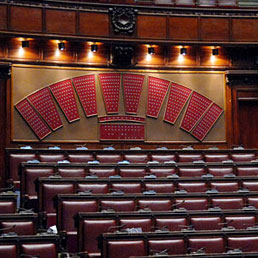Storia dell'articolo
Chiudi
Questo articolo è stato pubblicato il 08 gennaio 2013 alle ore 13:23.
 (Ansa)
(Ansa)
This law is based on a proportional system with the majority premium. The parties can create coalitions and present the electors with blocked regional or constituency lists. Therefore the elector only votes for the list while it is not possible to select the single candidates. The vote given to the list is also needed to award the majority premium.
Note: the "list" is a list of candidates indicated by the parties. Therefore the elector votes for the party by choosing a list.
Electoral system in the Chamber
• The 617 seats in the Chamber (all except for the 12 seats for Italians abroad and those due to Valle d'Aosta, awarded in a uninominal constituency) are assigned to the coalitions and to the lists through a proportional distribution on a national level (with the method of a natural quota). The list or coalition which obtains the most votes receives a minimum of 340 seats (54% of the Chamber). If this quota is not achieved through an initial distribution, it is then awarded officially. The remaining seats are proportionally distributed to the other lists and coalitions.
• The law provides for various thresholds: 10% for the coalitions; 4% for the lists lacking a coalition; 2% for the lists in a coalition; for each coalition that has achieved 10%, the first party below 2% is moreover brought back ("the best loser clause"). In other words, if a coalition achieves 10% of the votes, those lists that make up the coalition only need 2% of the votes to obtain seats (except for the best loser clause). If the coalition does not achieve 10%, only the lists in the coalition that have achieved 4% of the votes can obtain seats.
• In order to win and obtain the majority premium of 340 seats, in any case it is necessary to obtain one vote more than the opposing party/coalition. In order to do so, all the votes "count", even those of lists joined in an alliance but that do not reach the threshold.
• The lists are blocked. It is possible to be present in various constituencies, thereby creating the phenomena of the pluri-elected who exercise the option of determining who should and should not enter Parliament.
The electoral system in the Senate
• The distribution of seats given to the lists and coalitions in the Senate takes place on a regional level. With the exception of the 6 seats due to the Italians abroad, the 7 of Trentino Alto-Adige, the 2 of Molise and the seat of Valle d'Aosta, the remaining 299 seats in the Senate are awarded through 17 regional majority premiums: if at the first regional distribution (with the natural quota method) the winning list or coalition does not obtain at least 55% of the seats in the region, such a quota of seats will be officially assigned and the remaining seats will be distributed to the other lists and coalitions.
• The threshold is calculated on a regional basis: 20% for the coalitions; 8% for the lists that are not in an alliance; 3% for the lists in an alliance. The mechanism is the same as the one explained above for the Chamber. Here however the discount is more than 60%.
• The electoral system in the Senate appears like a real lottery: because of the 17 different regional premiums, not only is there no certainty for a solid majority, but it is not even certain that the majority of the seats will be given to the coalition that has obtained more votes than the others and not even that the seats will be given to the same coalition that has won in the Chamber. It should not be forgotten that for this branch of Parliament only those who are 25 years of age can vote, while the 18 year olds vote for the Chamber.
• The lists are blocked. It is possible to be present in more than one constituency.
©RIPRODUZIONE RISERVATA
Permalink
Dai nostri archivi
Moved Permanently
The document has moved here.










